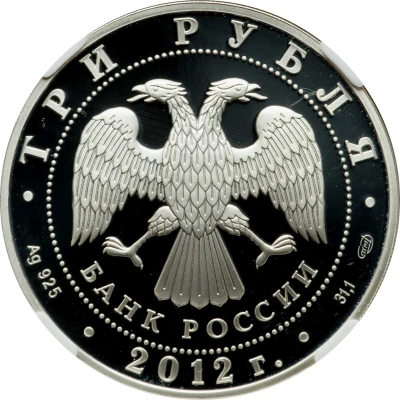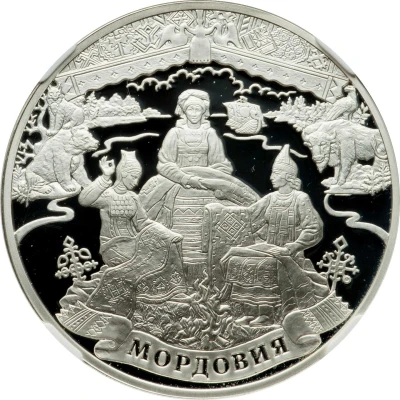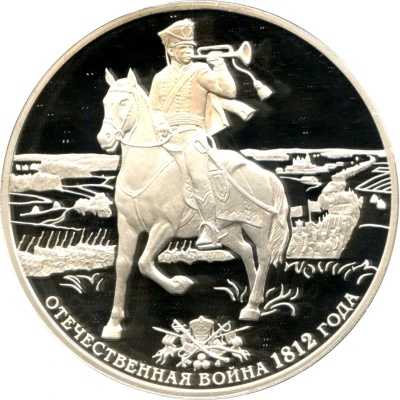


3 Rouble People's Voluntary Corps
2012 year| Silver (.925) | 33.94 g | 39 mm |
| Issuer | Russia |
|---|---|
| Period | Russian Federation (1991-date) |
| Type | Non-circulating coin |
| Year | 2012 |
| Value | 3 Roubles 3 RUB = USD 0.031 |
| Currency | Rouble (1998-date) |
| Composition | Silver (.925) |
| Weight | 33.94 g |
| Diameter | 39 mm |
| Thickness | 3.30 mm |
| Shape | Round |
| Technique | Milled |
| Orientation | Medal alignment ↑↑ |
| Updated | 2024-10-07 |
| Numista | N#32375 |
|---|---|
| Rarity index | 86% |
Reverse
Bearded man wearing a fur hat (Kuzma Minin). Bearded man in a helmet and chainmail (Dmitry Pozharsky). Christ's banner.
Script: Cyrillic
Lettering:
1612
НАРОДНОЕ
ОПОЛЧЕНИЕ
Translation: People's Militia
Engravers: Alexandra Arsenyevna Dolgopolova, Alexander Nikolaevich Bessonov
Designer: Sergey Vladilenovich Sutyagin
Edge
300 corrugations
Comment
Date of issue 30 JAN 2012
The Second People's Militia (Second Zemsky Militia) emerged in 1611 in Nizhny Novgorod to combat Polish interventions. The initiative for its organization came from the Nizhny Novgorod craftsmen and merchants. Playing a prominent role in organizing the militia was the Nizhny Novgorod district elder, Kozma Minin. Historians believe Minin's famous calls to liberation resonated initially among the townspeople, then gained support from the Nizhny Novgorod city council, voivode, clergy, and service class. A significant impetus to this movement was a letter from Patriarch Hermogenes, imprisoned in Chudov Monastery, urging the people of Nizhny Novgorod to stand for the holy cause of liberating Russia from foreign invaders. At a meeting convened by Minin in the Spaso-Preobrazhensky Cathedral of the Nizhny Novgorod Kremlin, a "verdict" was reached that all residents of the city and district must contribute part of their property for the formation of military forces. Minin was tasked with overseeing the collection and distribution of funds among the future militia fighters.
At a subsequent meeting, the people of Nizhny Novgorod decided to ask Prince Dmitry Pozharsky to lead the militia, whose ancestral estate was in the Nizhny Novgorod district. By that time, Prince Pozharsky had significant military experience: in 1608, as a regimental voivode, he defeated a detachment under False Dmitry near Kolomna; in 1609, he routed the gangs of Ataman Salkov; in 1610, amid the turmoil between Tsar Vasily Shuisky and the Ryazan voivode, he held the city of Zaraysk loyal to the Tsar; in 1611, he bravely fought the enemies in Moscow, where he was severely wounded. Pozharsky agreed to lead the militia on the condition that all his economic affairs would be managed by K. Minin.
In October 1611, Prince Pozharsky and K. Minin began forming the militia. Letters were sent to many cities and districts calling for warriors and financial contributions. By the end of 1611, the militia had grown from 750 to 3,000 people. It included service-class individuals from western lands fleeing from the Poles, residents of neighboring regions near Nizhny Novgorod, residents of Kolomna, Ryazan, Cossacks, and musketeers from Ukrainian cities. The influx of service-class people into the militia was facilitated by the efficient organization of fundraising and the stable financial support provided to them (30-50 rubles per year).
During the winter of 1611-1612, the Second Militia established its chancellery and government, called the "Council of the Entire Land." It included militia leaders, members of the Nizhny Novgorod city council, and representatives from other cities. The authorities of the Second Militia essentially assumed the functions of the Russian government, opposing the Moscow "seven boyars" and the Moscow-independent Cossack "tabor" led by Prince D.T. Trubetskoy and Ataman I.I. Zarutsky.
In February 1612, the Second Militia marched from Nizhny Novgorod towards Moscow and by early April reached Yaroslavl, where they stayed for four months. Along the way, the militia cleared cities and lands from Polish-Lithuanian detachments, local authorities who had sworn allegiance to False Dmitry II, and bandit gangs. During this period, many cities and districts of the north, northeast, Podmoskovye, Pomorye, and Siberia joined the Second Militia. The militia's army grew to 10,000 well-armed and trained fighters. In Yaroslavl, the composition of the Second Militia government was finally determined, and several orders were established to carry out administrative and judicial activities.
The main forces of the Second Militia marched from Yaroslavl to Moscow on July 28, 1612, and on August 19 approached the walls of Moscow. The complete liberation of the city was achieved two months later. The Polish detachments entrenched in Kitay-gorod and the Kremlin, despite severe famine, resisted for a long time. On October 22, Kitay-gorod was stormed by Russian forces, and on October 26, the surrendering Poles left the Kremlin. On October 27, the triumphant entry into the Kremlin was made by the troops of Pozharsky and Prince D.T. Trubetskoy. Thus, the liberation of Moscow and the Moscow state from foreign invaders was completed.
Interesting fact
The 3 Rouble (People's Voluntary Corps) 2012 coin from Russia features an image of a volunteer firefighter on its obverse side, which is unusual for a coin. This design was chosen to commemorate the 75th anniversary of the People's Voluntary Corps, a civil defense organization in Russia that was established in 1941 during World War II. The coin's unique design and historical significance make it a standout among other coins.
Price
| Date | Mintage | VG | F | VF | XF | AU | UNC |
|---|---|---|---|---|---|---|---|
| 2012 СПМД | 5000 | - | - | - | - | - | - |
Values in the table are based on evaluations by sales realized on Internet platforms. They serve as an indication only for 3 Rouble (People's Voluntary Corps) 2012 coin.



